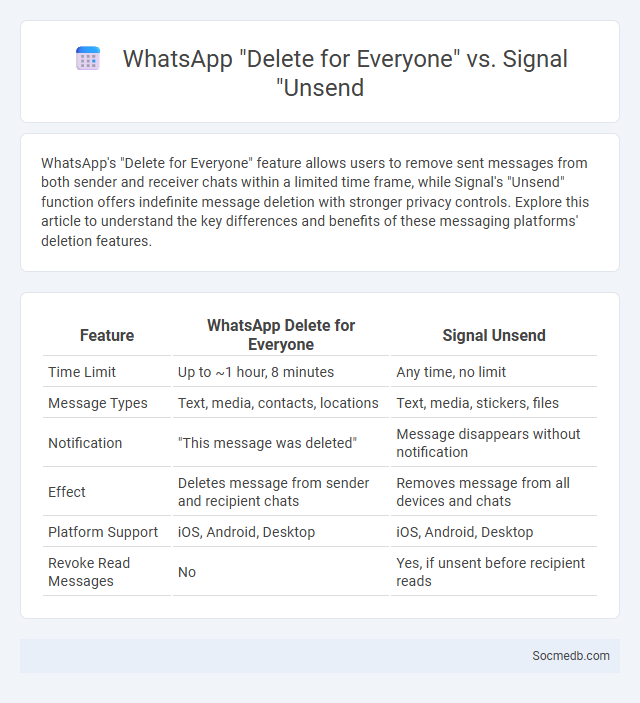
Photo illustration: WhatsApp Delete for Everyone vs Signal Unsend
WhatsApp's "Delete for Everyone" feature allows users to remove sent messages from both sender and receiver chats within a limited time frame, while Signal's "Unsend" function offers indefinite message deletion with stronger privacy controls. Explore this article to understand the key differences and benefits of these messaging platforms' deletion features.
Table of Comparison
| Feature | WhatsApp Delete for Everyone | Signal Unsend |
|---|---|---|
| Time Limit | Up to ~1 hour, 8 minutes | Any time, no limit |
| Message Types | Text, media, contacts, locations | Text, media, stickers, files |
| Notification | "This message was deleted" | Message disappears without notification |
| Effect | Deletes message from sender and recipient chats | Removes message from all devices and chats |
| Platform Support | iOS, Android, Desktop | iOS, Android, Desktop |
| Revoke Read Messages | No | Yes, if unsent before recipient reads |
Understanding Message Deletion: WhatsApp, Signal, and Others
Message deletion on platforms like WhatsApp, Signal, and others varies significantly in terms of timing, scope, and visibility. WhatsApp allows you to delete messages for everyone within a limited time frame, but recipients may still see notifications or message previews depending on their settings. Signal offers enhanced privacy by letting you delete messages both locally and remotely without leaving traces, strengthening your control over your conversations.
How “Delete for Everyone” Works on WhatsApp
WhatsApp's "Delete for Everyone" feature allows you to remove sent messages from both your chat and the recipient's chat within a limited time frame, typically around one hour after sending. The deletion works by sending a command to WhatsApp servers, which then instruct devices involved to replace the original message with a note indicating the message was deleted. This function ensures your message is no longer visible to recipients, helping you maintain control over your communication and privacy.
Signal’s “Unsend” Feature Explained
Signal's "Unsend" feature allows you to delete sent messages from both your device and the recipient's, enhancing privacy and control over your conversations. This functionality supports real-time message retraction within a limited time frame, ensuring sensitive information can be removed promptly. By using this feature, your social interactions on Signal remain more secure compared to typical social media messaging platforms.
Revoke Message Options: What Are They?
Revoke message options on social media platforms allow users to delete or retract sent messages within a specific time frame, enhancing privacy and control over shared content. These features vary across platforms, with some offering options to revoke messages for all recipients, while others restrict revocation to the sender's view only. Utilizing revoke options helps prevent misunderstandings, protect sensitive information, and maintain personal or professional boundaries in digital communication.
Time Limits: How Long Before You Can Recall a Message?
Time limits for recalling a message on social media vary widely between platforms: WhatsApp allows message deletion up to about 1 hour, 8 minutes, and 16 seconds after sending, while Facebook Messenger restricts it to 10 minutes. Twitter permits tweet deletion anytime, but direct messages can only be unsent within a short window, typically minutes after sending. Understanding these timeframes helps you manage your digital footprint and control what your audience sees on your profiles.
Notification Differences: What the Recipient Sees
Notification differences in social media platforms affect what the recipient sees, including variations in message previews, alert sounds, and badge icons. You might notice that some platforms display full message content in notifications, while others show only sender information to enhance privacy. These distinctions impact how quickly and effectively your audience responds to your messages or updates.
Message Deletion Across Devices: Sync and Consistency
Message deletion across devices ensures seamless synchronization by instantly removing content from all connected platforms, maintaining data consistency for users. This functionality relies on cloud-based protocols and real-time database updates to prevent message desynchronization and protect user privacy. Ensuring message deletion sync across devices enhances user trust and operational efficiency in social media communication.
Data Privacy and Security Implications
Social media platforms collect vast amounts of personal data, raising critical concerns about user privacy and data security. Unauthorized data breaches and misuse of information can lead to identity theft, targeted cyberattacks, and erosion of consumer trust. Implementing robust encryption, strict access controls, and transparent data policies is essential to safeguard user data in the digital landscape.
User Experience: Ease of Use and Limitations
Social media platforms prioritize user experience by offering intuitive interfaces that simplify navigation and content sharing, enhancing Your engagement and satisfaction. These platforms often incorporate features like personalized feeds, easy multimedia uploading, and interactive tools to facilitate seamless communication. However, limitations such as privacy concerns, algorithmic biases, and occasional technical glitches can hinder usability and affect the overall social media experience.
Which App is Best for Message Deletion?
Telegram offers one of the most robust message deletion features, allowing users to delete messages for both themselves and recipients at any time without a time limit, enhancing privacy and control over conversations. WhatsApp also provides a reliable delete-for-everyone option, enabling message removal within a 2-day window, with notifications indicating when messages are deleted. Signal emphasizes privacy by allowing message deletion without traces on both sender and receiver devices, combined with encrypted messaging for maximum security.
 socmedb.com
socmedb.com